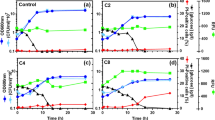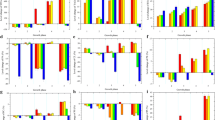Abstract
In order to compete with petroleum-based fuel and chemicals, engineering a robust biocatalyst that can convert renewable feedstocks into biorenewable chemicals, such as carboxylic acids, is increasingly important. However, product toxicity is often problematic. In this study, the toxicity of the carboxylic acids hexanoic, octanoic, and decanoic acid on Saccharomyces cerevisiae was investigated, with a focus on octanoic acid. These compounds are completely inhibitory at concentrations of magnitude 1 mM, and the toxicity increases as chain length increases and as media pH decreases. Transciptome analysis, reconstruction of gene regulatory network, and network component analysis suggested decreased membrane integrity during challenge with octanoic acid. This was confirmed by quantification of dose-dependent and chain length-dependent induction of membrane leakage, though membrane fluidity was not affected. This induction of membrane leakage could be significantly decreased by a period of pre-adaptation, and this pre-adaptation was accompanied by increased oleic acid content in the membrane, significantly increased production of saturated lipids relative to unsaturated lipids, and a significant increase in the average lipid chain length in the membrane. However, during adaptation cell surface hydrophobicity was not altered. The supplementation of oleic acid to the medium not only elevated the tolerance of yeast cells to octanoic acid but also attenuated the membrane leakiness. However, while attempts to mimic the oleic acid supplementation effects through expression of the Trichoplusia ni acyl-CoA Δ9 desaturase OLE1(TniNPVE desaturase) were able to increase the oleic acid content, the magnitude of the increase was not sufficient to reproduce the supplementation effect and increase octanoic acid tolerance. Similarly, introduction of cyclopropanated fatty acids through expression of the Escherichia coli cfa gene was not helpful for tolerance. Thus, we have provided quantitative evidence that carboxylic acids damage the yeast membrane and that manipulation of the lipid content of the membrane can increase tolerance, and possibly production, of these valuable products.





Similar content being viewed by others
References
Abbott DA, Knijnenburg TA, de Poorter LMI, Reinders MJT, Pronk JT, van Maris AJA (2007) Generic and specific transcriptional responses to different weak organic acids in anaerobic chemostat cultures of Saccharomyces cerevisiae. FEMS Yeast Res 7:819–833
Abbott DA, Zelle RM, Pronk JT, van Maris AJA (2009) Metabolic engineering of Saccharomyces cerevisiae for production of carboxylic acids: current status and challenges. FEMS Yeast Res 9:1123–1136
Abdulrehman D, Monteiro PT, Teixeira MC, Mira NP, Lourenco AB, dos Santos SC, Cabrito TR, Francisco AP, Madeira SC, Aires RS, Oliveira AL, Sá-Correia I, Freitas AT (2011) Yeastract: providing a programmatic access to curated transcriptional regulatory associations in Saccharomyces cerevisiae through a web services interface. Nucleic Acids Res 39:D136–40
Alexandre H, Berlot JP, Charpentier C (1994) Effect of ethanol on membrane fluidity of protoplasts from Saccharomyces cerevisiae and Kloeckera apiculata grown with or without ethanol, measured by fluorescence anisotropy. Biotechnol Tech 8:295–300
Alexandre H, Mathieu B, Charpentier C (1996) Alteration in membrane fluidity and lipid composition, and modulation of H+–ATPase activity in Saccharomyces cerevisiae caused by decanoic acid. Microbiol (UK) 142:469–475
Aono R, Kobayashi H (1997) Cell surface properties of organic solvent-tolerant mutants of Escherichia coli K-12. Appl Environ Microbiol 63:3637–3642
Baldi P, Hatfield GW (2002) DNA microarrays and gene expression: from experiments to data analysis and modeling. Cambridge University Press, Cambridge
Bhoite LT, Allen JM, Garcia E, Thomas LR, Gregory ID, Voth WP, Whelihan K, Rolfes RJ, Stillman DJ (2002) Mutations in the Pho2 (Bas2) transcription factor that differentially affect activation with its partner proteins Bas1, Pho4, and Swi5. J Biol Chem 277:37612–37618
Bligh EG, Dyer WJ (1959) A rapid method of total lipid extraction and purification. Can J Biochem Physiol 37:911–917
Brachmann CB, Davies A, Cost GJ, Caputo E, Li JC, Hieter P, Boeke JD (1998) Designer deletion strains derived from Saccharomyces cerevisiae S288C: a useful set of strains and plasmids for PCR-mediated gene disruption and other applications. Yeast 14:115–132
Cabral MG, Viegas CA, Sá-Correia I (2001) Mechanisms underlying the acquisition of resistance to octanoic-acid-induced-death following exposure of Saccharomyces cerevisiae to mild stress imposed by octanoic acid or ethanol. Arch Microbiol 175:301–307
Chang C, Ding Z, Hung YS, Fung PC (2008) Fast network component analysis (FastNCA) for gene regulatory network reconstruction from microarray data. Bioinformatics 24:1349–58
Chang YY, Cronan JE (1999) Membrane cyclopropane fatty acid content is a major factor in acid resistance of Escherichia coli. Mol Microbiol 33:249–259
Cohen R, Engelberg D (2007) Commonly used Saccharomyces cerevisiae strains (e.g. BY4741, W303) are growth sensitive on synthetic complete medium due to poor leucine uptake. FEMS Microbiol Lett 273:239–243
Erturk M (2011) Economic analysis of unconventional liquid fuel sources. Renew Sust Energ Rev 15:2766–2771
Faith JJ, Driscoll ME, Fusaro VA, Cosgrove EJ, Hayete B, Juhn FS, Schneider SJ, Gardner TS (2008) Many microbe microarrays database: uniformly normalized Affymetrix compendia with structured experimental metadata. Nucleic Acids Res 36:D866–70
Fang F, Salmon K, Shen MWY, Aeling KA, Ito E, Irwin B, Tran UPC, Hatfield GW, Da Silva NA, Sandmeyer S (2011) A vector set for systematic metabolic engineering in Saccharomyces cerevisiae. Yeast 28:123–136
Fu Y, Jarboe LR, Dickerson JA (2011) Reconstructing genome-wide regulatory network of E. coli using transcriptome data and predicted transcription factor activities. BMC Bioinforma 12:233
Heipieper HJ, Weber FJ, Sikkema J, Keweloh H, Debont JAM (1994) Mechanisms of resistance of whole cells to toxic organic-solvents. Trends Biotechnol 12:409–415
Hermann BG, Patel M (2007) Today's and tomorrow's bio-based bulk chemicals from white biotechnology —a techno-economic analysis. Appl Biochem Biotechnol 136:361–388
Hung SP, Baldi P, Hatfield GW (2002) Global gene expression profiling in Escherichia coli K12—the effects of leucine-responsive regulatory protein. J Biol Chem 277:40309–40323
Ingram LO (1986) Microbial tolerance to alcohols—role of the cell-membrane. Trends Biotechnol 4:40–44
Ingram LO, Buttke TM (1984) Effects of alcohols on microorganisms. Adv Microb Physiol 25:253–300
Jarboe LR, Liu P, Royce LA (2011) Engineering inhibitor tolerance for the production of biorenewable fuels and chemicals. Curr Opin Chem Eng 1:38–42
Kabara JJ, Eklund T (1991) Organic acids and esters. In: Russel NJ, Gould GW (eds) Food preservative. Blackie, Glasgow, pp 44–71
Kajiwara S, Aritomi T, Suga K, Ohtaguchi K, Kobayashi O (2000) Overexpression of the OLE1 gene enhances ethanol fermentation by Saccharomyces cerevisiae. Appl Microbiol Biotechnol 53:568–574
Keweloh H, Diefenbach R, Rehm HJ (1991) Increase of phenol tolerance of Escherichia coli by alterations of the fatty-acid composition of the membrane-lipids. Arch Microbiol 157:49–53
Legras JL, Erny C, Le Jeune C, Lollier M, Adolphe Y, Demuyter C, Delobel P, Blondin B, Karst F (2010) Activation of two different resistance mechanisms in Saccharomyces cerevisiae upon exposure to octanoic and decanoic acids. Appl Environ Microbiol 76:7526–7535
Lennen RM, Braden DJ, West RM, Dumesic JA, Pfleger BF (2010) A process for microbial hydrocarbon synthesis: overproduction of fatty acids in Escherichia coli and catalytic conversion to alkanes. Biotechnol Bioeng 106:193–202
Lennen RM, Kruziki MA, Kumar K, Zinkel RA, Burnum KE, Lipton MS, Hoover SW, Ranatunga DR, Wittkopp TM, Marner WD, Pfleger BF (2011) Membrane stresses induced by overproduction of free fatty acids in Escherichia coli. Appl Environ Microbiol 77:8114–8128
Lennen RM, Pfleger BF (2012) Engineering Escherichia coli to synthesize free fatty acids. Trends Biotechnol 30:659–667
Liao JC, Boscolo R, Yang YL, Tran LM, Sabatti C, Roychowdhury VP (2003) Network component analysis: reconstruction of regulatory signals in biological systems. Proc Natl Acad Sci U S A 100:15522–15527
Liu P, Jarboe LR (2012) Metabolic engineering of biocatalysts for carboxylic acids production. CSBJ 3: e201210011, http://dx.doi.org/10.5936/csbj.201210011
Mäki-Arvela P, Kubickova I, Snåre M, Eränen K, Murzin DY (2007) Catalytic deoxygenation of fatty acids and their derivatives. Energ Fuel 21:30–41
Mizoguchi H, Hara S (1998) Permeability barrier of the yeast plasma membrane induced by ethanol. J Biosci Bioeng 85:25–29
Namiki Y, Ueno K, Mitani H, Virtudazo EV, Ohkusu M, Shimizu K, Kawamoto S, Chibana H, Yamaguchi M (2011) Scanning and negative-staining electron microscopy of protoplast regeneration of a wild-type and two chitin synthase mutants in the pathogenic yeast Candida glabrata. J Electron Microsc 60:157–165
Nikolau BJ, Perera MADN, Brachova L, Shanks B (2008) Platform biochemicals for a biorenewable chemical industry. Plant J 54:536–545
Osman YA, Ingram LO (1985) Mechanism of ethanol inhibition of fermentation in Zymomonas mobilis cp4. J Bacteriol 164:173–180
Perez JM, Richter H, Loftus SE, Angenent LT (2012) Biocatalytic reduction of short-chain carboxylic acids into their corresponding alcohols with syngas fermentation. Biotechnol Bioeng. doi:10.1002/bit.24786
Prashar A, Hili P, Veness RG, Evans CS (2003) Antimicrobial action of palmarosa oil (Cymbopogon martinii) on Saccharomyces cerevisiae. Phytochem 63:569–575
Ramos JL, Duque E, Gallegos MT, Godoy P, Ramos-Gonzalez MI, Rojas A, Teran W, Segura A (2002) Mechanisms of solvent tolerance in gram-negative bacteria. Ann Rev Microbiol 56:743–768
Rosenberg M, Gutnick D, Rosenberg E (1980) Adherence of bacteria to hydrocarbons—a simple method for measuring cell-surface hydrophobicity. FEMS Microbiol Lett 9:29–33
Sá-Correia I, Salgueiro SP, Viegas CA, Novais JM (1989) Leakage induced by ethanol, octanoic and decanoic acids in Saccharomyces cerevisiae. Yeast 5:123–127
Salgueiro SP, Sá-Correia I, Novais JM (1988) Ethanol-induced leakage in Saccharomyces cerevisiae: kinetics and relationship to yeast ethanol tolerance and alcohol fermentation productivity. Appl Environ Microbiol 54:903–909
Salmon K, Hung SP, Mekjian K, Baldi P, Hatfield GW, Gunsalus RP (2003) Global gene expression profiling in Escherichia coli K12: the effects of oxygen availability and FNR. J Biol Chem 278:29837–55
Salmon KA, Hung SP, Steffen NR, Krupp R, Baldi P, Hatfield GW, Gunsalus RP (2005) Global gene expression profiling in Escherichia coli K12: effects of oxygen availability and ArcA. J Biol Chem 280:15084–15096
Segura A, Molina L, Fillet S, Krell T, Bernal P, Munoz-Rojas J, Ramos JL (2012) Solvent tolerance in Gram-negative bacteria. Curr Opin Biotechnol 23:415–421
Singh RP, Prasad HK, Sinha I, Agarwal N, Natarajan K (2011) Cap2–HAP complex is a critical transcriptional regulator that has dual but contrasting roles in regulation of iron homeostasis in Candida albicans. J Biol Chem 286:25154–25170
Steen EJ, Kang Y, Bokinsky G, Hu Z, Schirmer A, McClure A, del Cardayre SB, Keasling JD (2010) Microbial production of fatty-acid-derived fuels and chemicals from plant biomass. Nature 463:559–U182
Vanderrest ME, Kamminga AH, Nakano A, Anraku Y, Poolman B, Konings WN (1995) The plasma-membrane of Saccharomyces cerevisiae: structure, function, and biogenesis. Microbiol Rev 59:304–322
Viegas CA, Almeida PF, Cavaco M, Sá-Correia I (1998) The H+–ATPase in the plasma membrane of Saccharomyces cerevisiae is activated during growth latency in octanoic acid-supplemented medium accompanying the decrease in intracellular pH and cell viability. Appl Environ Microbiol 64:779–783
Viegas CA, Cabral MG, Teixeira MC, Neumann G, Heipieper HJ, Sá-Correia I (2005) Yeast adaptation to 2,4-dichlorophenoxyacetic acid involves increased membrane fatty acid saturation degree and decreased OLE1 transcription. Biochem Bioph Res Co 330:271–278
Viegas CA, Rosa MF, Sá-Correia I, Novais JM (1989) Inhibition of yeast growth by octanoic and decanoic acids produced during ethanolic fermentation. Appl Environ Microbiol 55:21–28
You KM, Rosenfield CL, Knipple DC (2003) Ethanol tolerance in the yeast Saccharomyces cerevisiae is dependent on cellular oleic acid content. Appl Environ Microbiol 69:1499–1503
Zaldivar J, Martinez A, Ingram LO (1999) Effect of selected aldehydes on the growth and fermentation of ethanologenic Escherichia coli. Biotechnol Bioeng 65:24–33
Zhang X-S, Garcia-Contreras R, Wood TK (2007) YcfR (BhsA) influences Escherichia coli biofilm formation through stress response and surface hydrophobicity. J Bacteriol 189:3051–3062
Acknowledgments
This work was supported by the National Science Foundation Engineering Research Center for Biorenewable Chemicals, NSF award number EEC-0813570. We thank Kimberly Booe from Iowa State University and Charles Henkel from Louisiana State University, participants in the CBiRC REU at Iowa State University, for their help in this work.
Author information
Authors and Affiliations
Corresponding author
Rights and permissions
About this article
Cite this article
Liu, P., Chernyshov, A., Najdi, T. et al. Membrane stress caused by octanoic acid in Saccharomyces cerevisiae . Appl Microbiol Biotechnol 97, 3239–3251 (2013). https://doi.org/10.1007/s00253-013-4773-5
Received:
Revised:
Accepted:
Published:
Issue Date:
DOI: https://doi.org/10.1007/s00253-013-4773-5




